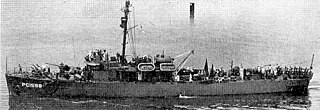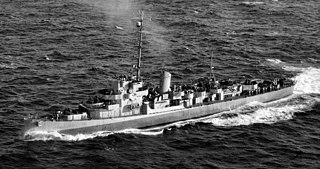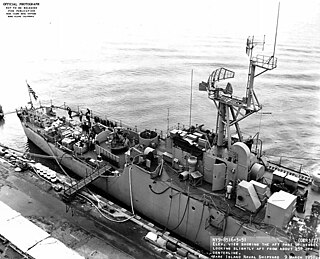
USS Long (DD-209/DMS-12), named for John Davis Long (1838–1915), Secretary of the Navy from 1897 to 1902, was a Clemson-class destroyer of the United States Navy.

Mahan-class destroyers of the United States Navy were a series of 18 destroyers of which the first 16 were laid down in 1934. The last two of the 18, Dunlap and Fanning, are sometimes considered a separate ship class. All 18 were commissioned in 1936 and 1937. Mahan was the lead ship, named for Rear Admiral Alfred Thayer Mahan, an influential historian and theorist on sea power.

USS Hopewell (DD-681) was a Fletcher-class destroyer in service the United States Navy from 1943 to 1947 and from 1951 to 1970. She was finally sunk as a target in 1972.

USS Vammen (DE-644) was a Buckley-class destroyer escort of the United States Navy.

USS Stembel (DD-644) was a Fletcher-class destroyer in service with the United States Navy from 1942 to 1947 and from 1951 to 1958. In 1961, she was transferred to Argentina where she served as ARA Rosales (D-22). She was scrapped in 1982.

USS Daly (DD-519), a Fletcher-class destroyer, was a ship of the United States Navy named for Marine Sergeant Major Daniel Daly, (1873–1937), one of the very few people to be twice awarded the Medal of Honor.

USS Drayton (DD-366) was a Mahan-class destroyer in the United States Navy before and during World War II. She was the second ship named for Captain Percival Drayton, a career naval officer who served during the American Civil War.

The fourth USS Flusser (DD-368) was a Mahan-class destroyer in the United States Navy before and during World War II. She was named for Charles W. Flusser.

USS Dufilho (DE-423), was a John C. Butler-class destroyer escort.

USS Walton (DE-361) was a John C. Butler-class destroyer escort in the United States Navy. It was named after Merrit Cecil Walton, a Marine Corps platoon sergeant with the U.S. 1st Marine Division, who died on Gavutu during the Battle of Guadalcanal and was posthumously awarded the Navy Cross for "extraordinary heroism".

USS Russell (DD-414) was a World War II-era Sims-class destroyer in the service of the United States Navy, named after Rear Admiral John Henry Russell. She was among the most decorated US Naval vessels of World War II.

USS Van Buren (PG-150/PF-42), a Tacoma-class frigate patrol frigate, was the second ship of the United States Navy to hold this name. The first Van Buren, a revenue cutter, was named for President Martin Van Buren; the second Van Buren honors Van Buren, Arkansas.

USS Weeden (DE-797) was a Buckley-class destroyer escort in service with the United States Navy from 1944 to 1946 and from 1950 to 1958. She was scrapped in 1969.

USS Manning (DE-199) was a Buckley-class destroyer escort in service with the United States Navy from 1943 to 1947. She was scrapped in 1969.

USS Shelter (AM-301) was an Admirable-class minesweeper built for the United States Navy during World War II. After service in the Pacific during World War II, Shelter was decommissioned in June 1946 and placed in reserve. In January 1964, she was transferred to South Vietnam for service in the Republic of Vietnam Navy as RVNS Chi Linh (HQ-11). She remained in South Vietnamese service until the collapse of that country in 1975. Chi Linh was one of several ships that fled from South Vietnam to the Philippines. She was then commissioned into the Philippine Navy in April 1976 as RPS Datu Tupas (PS-18), named after a chieftain of Cebu. The ship's fate is not reported in secondary sources.

USS Excel (AM-94) was an Adroit-class minesweeper of the United States Navy. Laid down on 19 December 1941 by the Jakobson Shipyard, Inc., Oyster Bay, Long Island, New York, launched on 10 May 1942, and commissioned on 11 December 1942. The ship was reclassified as a submarine chaser, PC-1598 on 1 June 1944.

USS Burrows (DE-105) was a Cannon-class destroyer escort built for the U.S. Navy during World War II. She served in both the Atlantic Ocean and the Pacific Ocean, and provided escort service against submarine and air attack for Navy vessels and convoys.

USS Joyce (DE-317) was originally commissioned as a US Coast Guard Edsall-class destroyer escort built for the U.S. Navy during World War II. She served in the Atlantic Ocean and the Pacific Ocean and provided destroyer escort protection against submarine and air attack for Navy vessels and convoys. During its World War II service, on two different engagements with enemy submarines, the Joyce rescued survivors of the tanker SS Pan- Pennsylvania and its sister ship USS Leopold. Joyce received one battle star for its service during World War II.

USS Edmonds (DE-406) was a John C. Butler-class destroyer escort in service with the United States Navy from 1944 to 1946 and from 1951 to 1965. She was scrapped in 1973.

USS Orestes (AGP-10) was a motor torpedo boat tender that served in the United States Navy from 1944 to 1946.




















